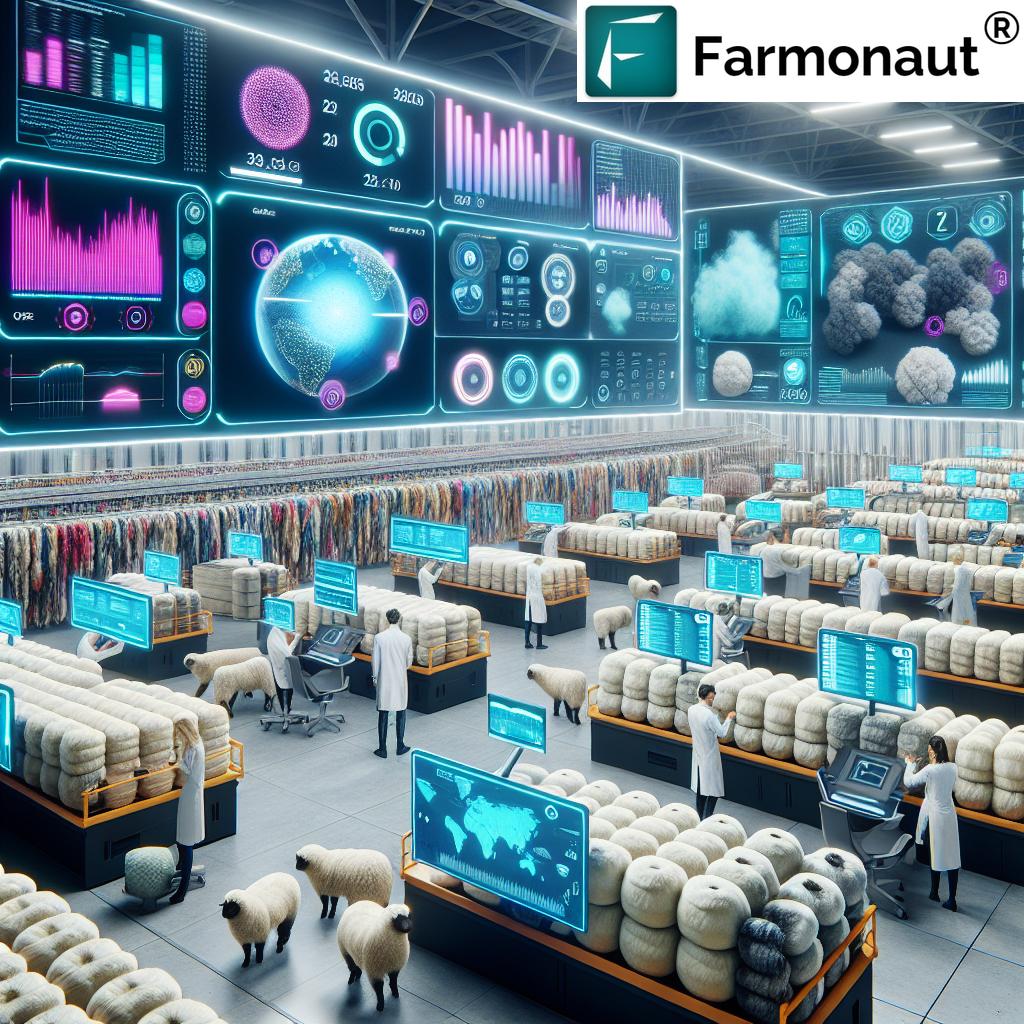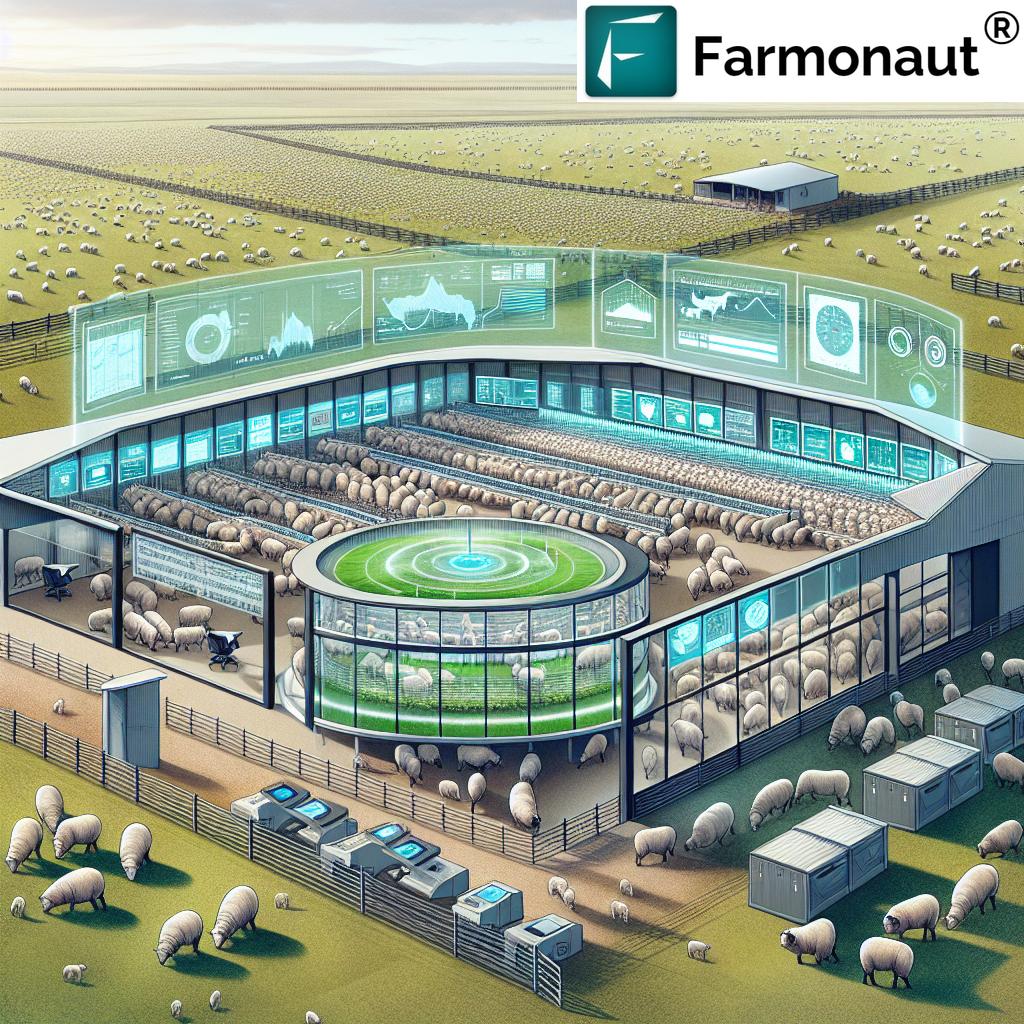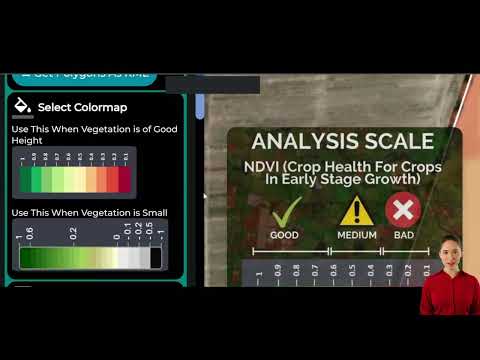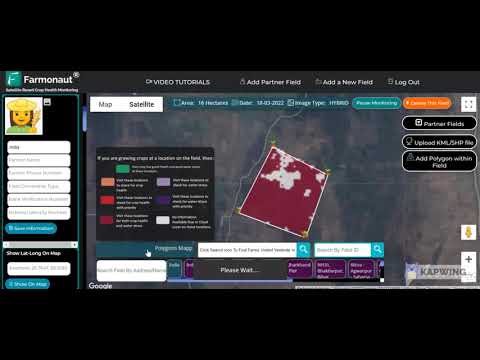Revolutionizing Australian Wool Industry: Data Standards and Digital Communication in 2024
“The Australian wool industry is adopting digital standards in 2024, potentially impacting over 70 million sheep nationwide.”

Welcome to our comprehensive exploration of the digital revolution sweeping through the Australian wool industry in 2024. As we delve into the world of wool industry data standards and electronic communication in agriculture, we’ll uncover how these advancements are reshaping the landscape of wool production and trade. At Farmonaut, we’re at the forefront of this transformation, providing cutting-edge agritech solutions that empower farmers and industry stakeholders alike.
In this blog post, we’ll examine the latest developments in farm data exchange, agricultural supply chain efficiency, and digital wool trading. We’ll also explore the critical role of standardization in enhancing agritech communication systems and promoting sustainable wool production. Join us as we navigate through the intricacies of agricultural data management and uncover how the Wool Industry EDI Handbook is paving the way for a more connected and efficient future.
The Dawn of Digital Transformation in the Australian Wool Industry
The Australian wool industry has long been a cornerstone of the nation’s agricultural sector. In 2024, we’re witnessing a paradigm shift as digital technologies and data standards revolutionize every aspect of wool production and trade. This transformation is not just about adopting new technologies; it’s about reimagining the entire wool supply chain for the digital age.
- Enhanced traceability from farm to fashion
- Improved efficiency in wool classing and grading
- Streamlined communication between industry stakeholders
- Data-driven decision-making for sustainable production
As we progress through 2024, the implementation of these digital standards is set to have a profound impact on the industry, affecting everything from small-scale farms to large wool processing facilities.
The Wool Industry EDI Handbook: A Game-Changer for Digital Communication
At the heart of this digital revolution lies the Wool Industry EDI Handbook. This comprehensive guide serves as the blueprint for standardizing electronic data interchange across the wool sector. By providing a common language for digital communication, the handbook is facilitating seamless information flow from the shearing shed to the auction floor and beyond.
Key components of the Wool Industry EDI Handbook include:
- Standardized data formats for wool specifications
- Protocols for electronic wool trading
- Guidelines for digital farm consignment data
- Frameworks for integrating blockchain technology in wool traceability
The adoption of these standards is accelerating in 2024, with industry-wide implementation expected to reach new heights by the end of the year.
Farmonaut’s Role in Advancing Agricultural Data Management
At Farmonaut, we’re proud to contribute to this digital transformation through our advanced agritech solutions. Our platform integrates seamlessly with the new industry standards, offering wool producers powerful tools for agricultural data management.
Here’s how Farmonaut is making a difference:
- Real-time satellite monitoring of pastures for optimal wool production
- AI-driven insights for sustainable grazing practices
- Integration with digital wool classer specifications for improved accuracy
- Blockchain-based traceability solutions for the wool supply chain
By leveraging these technologies, we’re helping Australian wool producers enhance their productivity while adhering to the latest industry standards.
Digital Wool Trading: Revolutionizing Market Dynamics
“Standardized electronic data interchange could reduce wool trading transaction times by up to 50% in the supply chain.”
The advent of digital wool trading platforms is transforming how wool is bought and sold in Australia. These platforms, built on the foundation of the Wool Industry EDI Handbook, are creating a more transparent, efficient, and accessible marketplace.
Benefits of digital wool trading include:
- Real-time price discovery and market analysis
- Reduced transaction costs and processing times
- Expanded market reach for producers of all sizes
- Enhanced traceability and quality assurance for buyers
As these platforms gain traction in 2024, we’re seeing a shift towards a more dynamic and responsive wool market that benefits all stakeholders.
Farm Data Exchange: Bridging the Gap Between Producer and Processor
Efficient farm data exchange is crucial for a smooth-functioning wool supply chain. In 2024, we’re witnessing the widespread adoption of standardized systems that facilitate the seamless transfer of information from the farm to the processing facility.
Key aspects of farm data exchange in the wool industry include:
- Digital recording of wool characteristics at shearing
- Automated transfer of farm consignment data to classers and brokers
- Integration with wool testing laboratories for rapid quality assessment
- Real-time updates on wool lot status throughout the supply chain
These advancements are not only improving efficiency but also enhancing the overall quality and consistency of Australian wool.

Wool Classer Specifications: Precision in the Digital Age
The role of the wool classer remains pivotal in ensuring the quality and consistency of Australian wool. In 2024, wool classer specifications are undergoing a digital transformation, aligning with the broader industry standards.
Digital wool classer specifications offer:
- Enhanced accuracy in recording wool characteristics
- Instant transmission of data to wool brokers and buyers
- Integration with farm management software for comprehensive record-keeping
- Improved traceability and quality assurance throughout the supply chain
This digital evolution is empowering wool classers to work more efficiently while contributing to the overall advancement of the industry.
Sustainable Wool Production: Leveraging Data for Environmental Stewardship
As the global demand for sustainable products continues to rise, the Australian wool industry is leveraging digital technologies to enhance its environmental credentials. Sustainable wool production is no longer just an aspiration but a measurable and achievable goal thanks to data-driven approaches.
Key initiatives in sustainable wool production include:
- Precision agriculture techniques for optimal pasture management
- Data-driven breeding programs for more efficient wool production
- Real-time monitoring of environmental impacts
- Blockchain-based verification of sustainable practices
At Farmonaut, we’re proud to offer solutions that support these sustainability efforts, helping wool producers achieve their environmental goals while maintaining productivity.
Explore Farmonaut’s API for advanced agricultural data insights
Agritech Communication Systems: The Backbone of Industry Connectivity
The success of the digital transformation in the Australian wool industry hinges on robust agritech communication systems. These systems serve as the conduit for the vast amounts of data generated at every stage of the wool production and trading process.
Essential elements of modern agritech communication systems include:
- High-speed rural internet connectivity
- Cloud-based data storage and processing
- Secure protocols for data transmission and sharing
- Interoperable software platforms across the supply chain
As these systems become more sophisticated and widespread in 2024, we’re seeing unprecedented levels of connectivity and collaboration within the industry.
The Future of Wool Industry Operations: A Data-Driven Perspective
As we look towards the future of wool industry operations, it’s clear that data will play an increasingly central role. From farm management to auction dynamics, every aspect of the industry is being reinvented through the lens of digital technology.
Emerging trends in wool industry operations include:
- AI-powered predictive analytics for market forecasting
- IoT devices for real-time monitoring of wool quality
- Virtual reality tools for remote wool inspection and trading
- Automated logistics systems for optimized wool transportation
These innovations are not just enhancing efficiency; they’re opening up new possibilities for value creation across the entire wool supply chain.
Access Farmonaut’s API Developer Docs for integration guidance
Overcoming Challenges in Digital Adoption
While the benefits of digital transformation in the wool industry are clear, the path to full adoption is not without its challenges. As we progress through 2024, industry stakeholders are working together to address these hurdles.
Key challenges and solutions include:
- Digital literacy: Implementing comprehensive training programs for farmers and industry professionals
- Infrastructure gaps: Investing in rural connectivity and digital infrastructure
- Data security concerns: Developing robust cybersecurity protocols for the industry
- Initial implementation costs: Offering financial incentives and support for digital adoption
By addressing these challenges head-on, the Australian wool industry is paving the way for a more resilient and competitive future.
The Role of Farmonaut in Shaping the Future of Wool Production
At Farmonaut, we’re committed to driving innovation in the agricultural sector, including the wool industry. Our suite of agritech solutions is designed to seamlessly integrate with the evolving digital landscape of wool production and trade.
Here’s how Farmonaut is contributing to the future of wool production:
- Providing satellite-based crop health monitoring for optimal pasture management
- Offering AI-driven advisory systems for sustainable farming practices
- Implementing blockchain-based traceability solutions for the wool supply chain
- Developing customized dashboards for comprehensive farm data management
By leveraging these technologies, we’re empowering wool producers to thrive in the digital age while adhering to the highest standards of quality and sustainability.
Comparative Analysis: Australian Wool Industry Digital Advancements 2024
| Data Standard/Technology | Implementation Status | Primary Benefits | Industry Impact (1-5 scale) |
|---|---|---|---|
| Wool Industry EDI Handbook | Fully Implemented | Standardized communication, Improved efficiency | 5 |
| Digital Wool Trading Platforms | Widespread Adoption | Market transparency, Reduced transaction times | 4 |
| Farm Data Exchange Systems | Rapidly Expanding | Seamless information flow, Enhanced traceability | 4 |
| Wool Classer Digital Specifications | Pilot Phase | Increased accuracy, Real-time data transmission | 3 |
Conclusion: Embracing the Digital Future of Wool
As we’ve explored throughout this blog post, the Australian wool industry is undergoing a profound digital transformation in 2024. From the adoption of standardized data formats to the implementation of advanced agritech solutions, every aspect of wool production and trade is being reimagined for the digital age.
The benefits of this transformation are far-reaching:
- Enhanced efficiency and productivity across the supply chain
- Improved traceability and quality assurance for wool products
- Greater market transparency and accessibility for producers of all sizes
- Increased sustainability through data-driven farming practices
At Farmonaut, we’re proud to be at the forefront of this revolution, offering cutting-edge solutions that empower wool producers to thrive in this new digital landscape. As we look to the future, we’re excited about the endless possibilities that lie ahead for the Australian wool industry.
By embracing these digital advancements and working together towards common standards, the Australian wool industry is not just securing its place in the global market – it’s setting the benchmark for agricultural innovation in the 21st century.
FAQs
- Q: How are digital standards improving the Australian wool industry?
A: Digital standards are enhancing efficiency, traceability, and sustainability across the wool supply chain, from farm to fashion. - Q: What is the Wool Industry EDI Handbook?
A: It’s a comprehensive guide that standardizes electronic data interchange in the wool sector, facilitating seamless communication and data flow. - Q: How does Farmonaut contribute to the wool industry’s digital transformation?
A: Farmonaut offers advanced agritech solutions, including satellite monitoring and AI-driven insights, to support sustainable and efficient wool production. - Q: What are the main challenges in adopting digital technologies in the wool industry?
A: Key challenges include digital literacy, infrastructure gaps, data security concerns, and initial implementation costs. - Q: How is sustainability being addressed through digital advancements in wool production?
A: Digital technologies enable precision agriculture, data-driven breeding programs, and real-time environmental monitoring, all contributing to more sustainable wool production practices.






